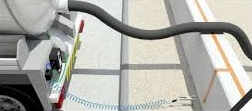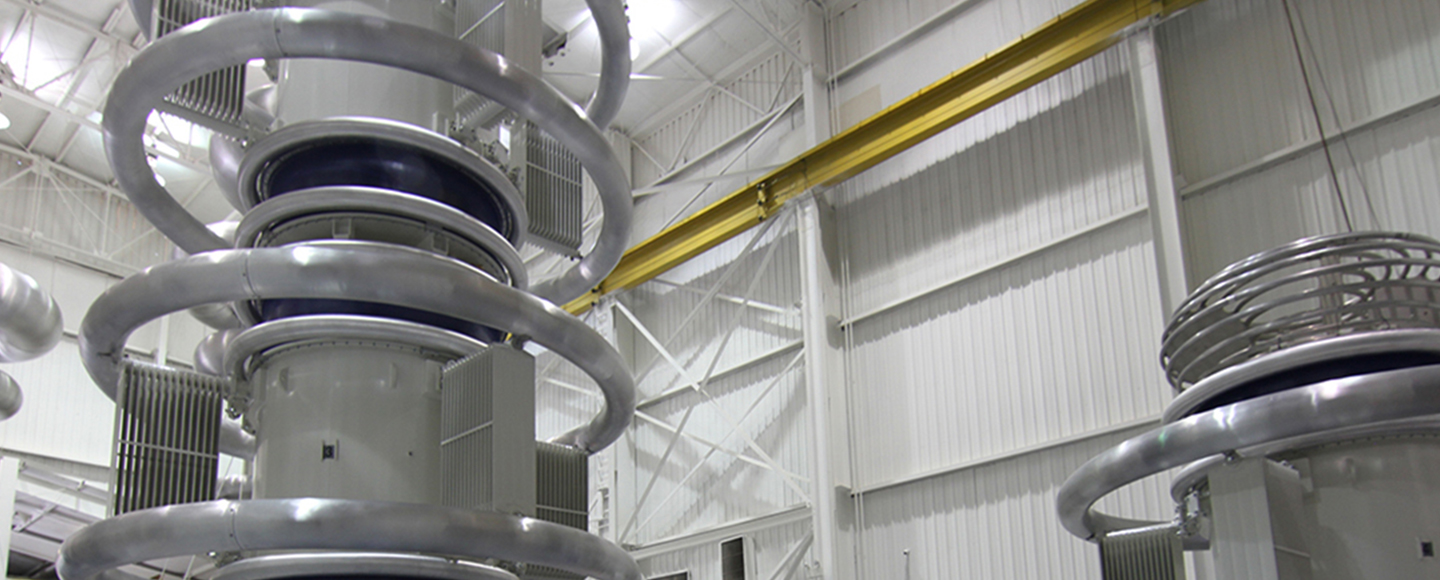Ini adalah Contoh Perhitungan Studi Kasus Elektrostatis yang pernah terjadi Untuk Pabrik dan Industri , dimana HOSE berbahan neoprene dilengkapi kawat helix logam. Adapun kawat heliks logam akan terhubung ke truk melalui kawat logam yang terdapat pada Hose.

Arus (Streaming Current) dari cairan/liquid mengalir melalui selang/hose dapat diperkirakan dari persamaan sbb:
Streaming Current Is = (2.5 x 10-5) (v2)(d2)
Dimana:
V = kecepatan cairan/liquid (meter per detik)
D = diameter internal selang (meter)
Diketahui bahwa laju alir isap/ suction adalah 500 galon per menit yang setara dengan 3,9 meter per detik. Diameter internal
selang adalah 4 inci yang setara dengan 0,102 meter.
Oleh karena itu, Streaming Current diperkirakan antara 3 mikro-ampli (3×10-6 A). Diperkirakan resitansi antara truk dan ground setidaknya 1x 1010 ohm. Sebagian besar resistansi akan diberikan oleh roda truk dan aspal tempat truk parkir.
Tegangan truk bisa diasumsikan mencapai tingkat paling tidak:
V = R x I
Dimana V = tegangan sistem selang truk
I = Streaming Current toluena
R = hambatan terhadap ground dari sistem selang truk
V = (1 x 1010). (3×10-6)
Tegangan truk minimal = 30.000 volt
Seperti yang dinyatakan sebelumnya selang itu dibuat dari neoprene dengan heliks kawat logam. Ini berarti spiral logam tidak berhubungan langsung dengan benda eksternal.
Selain itu, neoprene adalah material resistivitas tinggi dengan kekuatan dielektrik yang beberapa kali lebih besar dari udara dengan nilai khas 10.000 volt yang dibutuhkan per mm celah percikan.
Lapisan neoprene berdiameter 2 mm (0,08 inci). Ini berarti bahwa untuk setiap milimeter jarak antara helix logam dan tong logam pasti ada tegangan yang cukup tinggi untuk melepaskan percikan dengan energi yang cukup melebihi MIE toluena.
Untuk menguraikan neoprene, setidaknya 20.000 volt harus ada untuk mencapainya. Mengingat bahwa tegangan minimum pada sistem selang truk diperkirakan paling sedikit 30.000 volt, berarti 10.000 volt ekstra akan terjadi untuk melepaskan dari permukaan neoprene.
Jadi, pada suatu saat dalam operasi, celah antara permukaan selang dan aliran harus terjadi, sehingga terjadi percikan lengkap yang terjadi di celah yang memiliki uap toluena.
Bagian akhir dari perhitungan ini adalah energi potensial dari percikan itu sendiri. Kita dapat memperkirakan jumlah energi yang tersedia untuk debit melalui percikan dari persamaan:
Potensi energi percikan (Joule) = ½ x kapasitansi objek bermuatan x kuadrat dari voltase benda.
2E = ½ C V
Pengapian elektrostatik uap toluena selama operasi pengosongan truk.
Jika kita memperkirakan nilai rendah 1 nano-farad untuk nilai capacitance truk -9c (1×10 F) yang dikombinasikan dengan voltase 30.000 volt pada sistem selang truk pada saat pengapian, kita dapat mengasumsikan total energi potensial
450 Mili-joule, yang jauh melebihi MIE toluena yaitu 0,24 milijoule.
Persentase energi tertentu akan diberikan dalam bentuk suara dan panas radial, namun persentase yang signifikan akan dilepaskan pada celah percikan, memicu toluena dalam proses
___________________________________________________________________________________________________
This case study investigates the causes behind a fire that occurred during a vacuum truck operation. The vacuum truck was deployed to a below grade sump that contained mostly of “off-spec” toluene. As the vacuum truck operation was nearing completion of the removal of the toluene from the sump an ignition of the vapors occurred resulting in a fire. In the ensuing investigation of the incident it was determined that the vacuum truck had not been grounded by the operator. Although other ignition sources would have been considered, the fact that the truck was not grounded and the material being transferred was toluene, it was highly plausible that a static spark was the cause of the fire.
For a static spark to be discharged from the surface of a metal object there needs to be a voltage on the charged object that exceeds the “breakdown voltage” of the surrounding atmosphere. This voltage results from the presence of too many positive or negative charges on the object and simply means that the voltage of the charged object is strong enough to create a conductive channel through the air, to a secondary object. The conductive channel provides a path for the static charges to flow through. In the split second that the channel is formed, the excess charges rapidly pass through the gap releasing energy in the process. The energy released results in a static spark and if a flammable atmosphere is present in the “spark gap” there is a high probability the energy of the spark will exceed the minimum ignition energy (MIE) of the vapor, gas or dust present in the spark gap.
To create a voltage there needs to be a constant supply of electrical charges to the object being electrified, which in this case is the vacuum truck. Effective grounding of the truck would have provided a means of sending the excess electrical charges to the general mass of the earth (grounding) removing the risk of the truck becoming electrified. In electrical terms this means there was a very high resistance from the chassis/tank of the truck to earth. A constant stream of electrical charge is a current so the more current flowing to the truck, the greater its voltage. But where does this electrical current come from? This is where the vacuuming operation combined with the suction of a material like toluene would have created a “streaming current”. Toluene has a very high resistivity with the effect that when it comes into rapid and repeated contact with other objects, especially conductive objects like metals, it strips electrons from the other material. This means the toluene carries more negative charge than positive charge. When the charged toluene makes contact with the truck it causes the outer surface of the truck to carry the same amount of negative charge.
In the case of this incident a neoprene hose with an embedded metal wire helix was used. As the metal helix would have been connected to the truck via the metal couplings of the hose, the full length of the hose would have been at the same voltage as the truck. To put some “hard numbers” on the case for static being the source of ignition we need to look at some of the physical characteristics of this operation.
A streaming current for a resistive liquid flowing through a pipe (including hoses) can be estimated from the equation:
Streaming current, IS = (2.5×10-5)(v2)(d2)
Where:
v = velocity of liquid (metres per second)
d = internal diameter of hose (metres)
It is known that the suction flow rate was 500 gallons per minute which is equivalent to 3.9 metres per second. The internal dimeter of the hose was 4 inches which is equivalent to 0.102 metres. Hence the streaming current would have been somewhere in the region of 3 micro-amps (3×10-6 A). It was estimated that the resistance between the truck and ground was at least 1×1010 ohms. Most of the resistance would have been provided by the truck’s wheels and the asphalt on which the truck was positioned.
The voltage of the truck could be assumed to have reached a level of at least:
V = R x I
Where V = the voltage of the truck-hose system
I = the streaming current provided by the charged toluene
R = the resistance to ground of the truck-hose system
V = (1×1010).(3×10-6)
Minimum truck voltage = 30,000 volts
As the ignition of the vapors occurred in the sump, the discharge must have been from the hose to the metal rim of the sump. However, in order to prove this theory we must investigate the hose itself. As stated earlier the hose was made from neoprene with an embedded metal wire helix. This means that the metal spiral was not in direct physical contact with any external objects. In addition, neoprene is a high resistivity material with a dielectric strength that is several times greater than air with a typical value of 10,000 volts required per mm of spark gap. The neoprene layer was 2 mm (0.08 in.) in thickness. This would mean that for every millimetre of distance between the metal helix and the metal sump there must have been a high enough voltage to discharge a spark with enough energy to exceed the MIE of the toluene. In order to breakdown the neoprene, at least 20,000 volts must have been present to achieve this. Given that the minimum voltage on the truck-hose system is estimated to be at least 30,000 volts it means an extra 10,000 volts would have been present to discharge from the neoprene surface to the sump. So, at some point in the operation, a gap between the surface of the hose and the sump must have been created resulting in a complete spark being discharged across a gap that had toluene vapors present.
The final part of the jigsaw is the potential energy of the spark itself. We can estimate the amount of energy available for a discharge via the spark from the equation:
Potential energy of spark (Joules) = ½ x capacitance of
charged object x square of the object’s voltage.
E = ½ CV2

